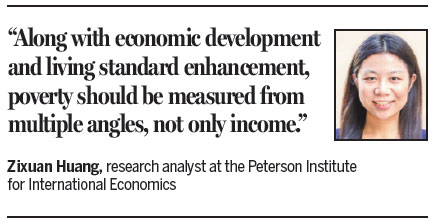Great strides made in poverty alleviation
Next steps involve rural land reform, fair distribution of wealth and education
While China's economy has experienced eye-catching growth during the last few decades, one of the most notable achievements has been the alleviation of poverty in the country.
The World Bank estimated that the number of people living in extreme poverty in China decreased from 836 million in 1987 to 156 million in 2010. China's poverty measure showed that just over 70 million people were living under the poverty line at the end of 2014.
What drove such impressive strides? Economic growth, urbanization and opening-up policies were largely behind this achievement. In the three decades from 1978 to 2007, gross domestic product increased an average of 10 percent annually, while the per capita annual income of rural households went from 134 yuan ($20.50) to 4,140 yuan. During the same period, poverty dropped from 30.7 percent to 1.6 percent of the population.
Urbanization has been another major driving force. A large number of rural people swarmed into urban areas to make a living. Although most were not eligible for social welfare and other resources limited to urban dwellers under China's restrictive system of hukou, or household registration, they earned more in cities than in the country.
At the same time, some families still living in rural areas abandoned farming and cultivation, trying their hands at nonagricultural jobs that were higher paid.
In addition, poverty alleviation is reinforced by opening-up policies. China's exports soared rapidly as globalization picked up speed, especially exports of labor-intensive products. Additionally, China's decision to allow more foreign enterprises and foreign investment in the country increased the number of jobs and reduced poverty.
This is not to say that poverty does not remain a serious problem. At present, China's slowdown in economic growth and its economic rebalancing raise the question of whether the recent pattern of poverty reduction can be sustained. How can China further eradicate poverty under the current complicated circumstances? The answer is: wealth distribution, human capital improvement and a shift to labor-intensive industries such as services.
First, wealth distribution. Benefits from rural land should be more fairly distributed to rural people through appropriate policy settings of rural land reform. Making full use of rural land and reasonable wealth distribution to rural people - thus increasing their income from properties of rural households - would be a crucial step in the right direction when it comes to rural land reform.
Second, human capital improvement should receive utmost attention. While the level of people's education has obviously risen over the past several decades, educational levels are still holding the Chinese economy back from its full potential. Fundamentally enhancing people's ability and savvy to produce economic value in a competitive world plays a significant role in poverty reduction.
Third, a shift to labor-intensive industries. China's attempt to make services a greater driver of its economy dovetails nicely with a shift to labor-intensive industries. This shift releases more employment opportunities and transfers surplus rural labor, with a positive outlook of services growth in the foreseeable future.
Furthermore, along with economic development and living standard enhancement, poverty should be measured from multiple angles, not only income. Health, education, resources and more could be added judiciously in the future, comprising a more multidimensional and nuanced poverty standard, instead of a simple poverty line.
The author is a research analyst at the Peterson Institute for International Economics.



















